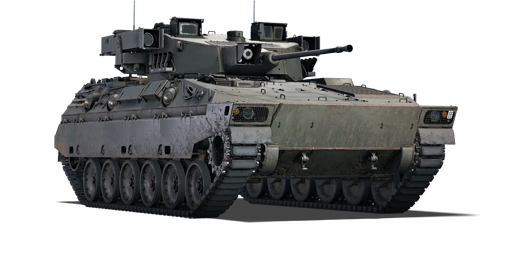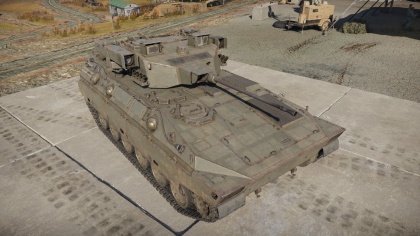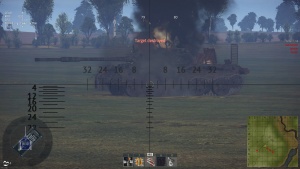Type 89
Contents
Description
The Type 89 is a rank VI Japanese light tank
with a battle rating of 9.0 (AB/RB/SB). It was introduced in Update 1.85 "Supersonic".
The full name is known as the Mitsubishi Type 89 infantry fighting vehicle (Japanese: 三菱89式装甲戦闘車 - Mitsubishi 89-shiki sōkō-sentō-sha), the Type 89 provides an autocannon weapon combined with an anti-tank guided missile for a diverse range of attack methods.
General info
Survivability and armour
While Type 89 armour consists out of Rolled Homogenous Armour, it is not any better than modern light tanks of other factions, which use double or even triple the amount of aluminium to give roughly the same amount of protection. This means that its sides and even angled turret will still be vulnerable to all autocannons and will "hull break" easily if hit into a weak spot. One such weak spot is the suspension, for example, hitting the back wheels of chassis with 105 mm chemical shell may annihilate entire tank.
Armour profile can be closely compared to Merkava Mk.1, it has a long hull with turret on the back, and the entirety of it is sloped as much as possible. This means that inaccurate frontal hull shot will likely bounce and tank should always face the opponent. Unfortunately, due to how big the turret is, the bounced shell might actually fly straight into it, and there aren't any special shields or additional armour for the turret crew on this tank.
Internal module placement is rather smart on paper, with driver and MG operator hiding on the right side of the tank, and main weapon crew hiding on the back along with ammunition, while the rest of the tank is one giant engine compartment, sealed off with 5 mm RHA screen. In reality, the means of protecting the crew and critical weak points are insufficient. Most notably, the driver isn't completely sealed away from tank's front and the turret.
Due to overall low thickness of armour Type 89 gets overmatched. Whenever the tank hull side is even slightly opened, it will get easily penetrated by big guns, the armour is not thin enough to not trigger APHE fuses and even if it's a slow 19 mm fuse it will trigger off hitting engine and RHA screen, then cause violent explosion next to ammo rack. Pure AP shells even of a small caliber autocannon will fly straight through the entire engine compartment, likely hitting the turret crew or ammo rack in the very back of the tank. It is also possible to lose entire tank crew to a single coaxial autocannon spray from the right side, as nothing is protecting the driver there.
The one time when when sealed compartment truly works is when Type 89 drives around the town, or hides from snipers behind buildings, and someone suddenly shoots engine compartment into direction opposite from the crew, then enemy APHE may simply get stuck there, doing reduced damage to the turret crew. This does not make situation any better, though, as without team help or very unlikely ATGM counterattack Type 89 will still get repeatedly set on fire until it explodes.
Recommendations: Keep your opponents in front of you, if you can't - at least keep them on your left. Avoid being shot directly by 120+ mm shells. Do not needlessly taunt enemy SPAA. In close quarters be extremely aggressive and destroy enemy weapon or gunner as soon as possible. Otherwise try to scout enemy and hope to fire first or that there is a sniper to cover your back.
Mobility
Write about the mobility of the ground vehicle. Estimate the specific power and manoeuvrability as well as the maximum speed forward and backwards.
Armaments
Main armament
The Type 89 is outfitted with the following:
- 1 x 35 mm Oerlikon KDE autocannon
- 4 x Type 79 ATGMs
Both of weapons are listed as "main armament" and should be treated equally. The gun covers the tank close quarter battles, while ATGM covers the unexpected and medium to long range encounters.
Its auto cannon is an Oerlikon KDE autocannon, which is similar to KDA variant used by the Gepard, the Type 87, and the Chieftain Marksman and is widely considered to be one of the most effective guns in regards to damage output and reliability. This is due to their moderate calibre and rate of fire: 35mm is the largest of the small autocannons which allows it to have a much higher rate of fire than any 40 mm or 57 mm system.
The difference between them is that KDE cannon fires slower than KDA, but it uses tank-specific ammunition instead, which makes it behave differently - for example, API-T will explode after penetration regardless of armour thickness (because planes have no armour), while APHE will explode only if it penetrates about 9 to 15 mm equivalent of Rolled Homogenous Armour, like with any normal tank shells. However, it generally does slightly more damage, if it does explode. Due to this, KDE shells also have tendency to penetrate modules like thin radiators and sometimes even engines, instead of just exploding upon hitting it, when attacking light tanks.
It is very important to remember, that even 3-5 direct APHE hits to a cannon barrel can neutralize almost any medium tank Type 89 can face, and should anything impenetrable suddenly attack, one can just fire at their gun.
This allows the Type 89 to easily deal with any lightly armoured vehicle in the game. It also has access to APDS ammunition, which allows it to deal with MBTs from the side, though this is usually not advised. It is also advisable to avoid attacking tanks like M3 Bradley from long range with a gun without APDS ammunition, as this light tank mostly specializes on annihilating other light tanks, has APDS from the get-go and it's hull can block almost any weak long range shots.
Tank still can use conventional HE instead of HEI-T to attack helicopters, if it must.
Whenever you see, that your gun can't deal with enemy target, or someone caught you off guard, you can launch ATGM. They are located on sides of a turret and can be launched on move at any speed as with hybrid medium tanks. Due to their placement, they only really arrive at crosshair location if target was about 500m away, so practice close range aim in test drive.
The Type 79 ATGM has around 700 mm flat penetration at any range and has a high velocity, making it one of the better ATGMs in-game, similar to MILAN 2 of Warrior, though it falls short of the HOT series. This ATGM lets you deal with most tanks from the front, but be sure to avoid hitting NATO NERA composite armour, as these composite armours will likely reduce damage done to minimal or none at all. Try to remove ERA with your gun, as it may reduce damage taken by hostile tank and force you to use both missiles.
Since you have two ATGMs mounted to the outside of your vehicle at once (with four total), you can immediately fire another missile after first one. Firing second missile will cut off the first one, so only do this if you are sure it's on correct course. Keep in mind, that you can only reload missiles after both of them were fired, and it takes 30 seconds, which is arguably the longest ATGM reload time in the game.
Machine guns
Offensive and anti-aircraft machine guns not only allow you to fight some aircraft but also are effective against lightly armoured vehicles. Evaluate machine guns and give recommendations on its use.
Usage in battles
Describe the tactics of playing in the vehicle, the features of using vehicles in the team and advice on tactics. Refrain from creating a "guide" - do not impose a single point of view but give the reader food for thought. Describe the most dangerous enemies and give recommendations on fighting them. If necessary, note the specifics of the game in different modes (AB, RB, SB).
Pros and cons
Pros:
- Has 2 ATGM loaded at the same time and can fire them in quick succession
- Unlike other IFV and non-hybrid ATGM carriers, can fire ATGM on move and at any speed
- Type 79 ATGM is hard to dodge and have high penetration power of 700 - can breach ERA and weak NERA
- Potent ammunition for autocannon - able to take out enemy tanks with one or two well-aimed penetrating hits:
- Second strongest APHE shell on an infantry fighting vehicle
- With APDS shells, can fight most medium tanks
- High explosive round can be used to one-shot low flying aircraft
- Can very efficiently exchange speed to manoeuvrability at gears 2 and 3
- Neutral steering
- Good reverse speed, turns better in reverse than forward
Cons:
- Weak armour - has hull break, can't completely negate damage, like the Warrior with add-on composite shields, can lose entire crew to a single 23 mm API-T and even APDS shot from the right side
- Low ammo count for the main gun and only 4 ATGM
- Due to placement of ATGM launchers on turret, firing them in close combat is awkward and may result in a non-fatal hit
- Unlike type 60 ATM, ATGM only reloads after you fired both of loaded missiles, forcing you to waste ammunition, on top of having only four ATGMs
- ATGM reload takes 30 seconds, which is three times slower than any other light tank and specialized ATGM carrier
- Unfavorable matchmaking compared to other infantry fighting vehicles like the M3 Bradley
- Driver is not able to handle first forward gear turning of the tank, resulting in abysmal forward first-gear turning speed. The problem can be avoided by manually shifting the transmission to gear 2 or driving forward until driver does it himself, but IFV will stutter in close combat
History
At the beginning of the 1980s, the JSDF wanted to replace its outdated Type 60 and Type 73 APCs with more modern IFVs, similar to the American Bradley and the German Marder. The JSDF drew up a set of requirements and tasked the Mitsubishi company with developing a suitable replacement.
In 1984, funding was approved to build four different prototypes, all of which underwent testing until 1986. By 1989, one prototype design was selected and was adopted within the armed forces under the designation of Type 89.
Initially, the JSDF estimated the need for about 300 Type 89s to be built. However, the end of the Cold War in the 1990s combined with a limited budget prevented a rapid mass-production of Type 89 to take place. In fact, production was proceeding at a very low rate, with just over 50 vehicles entering service with the JSDF by 1999.
Although production of Type 89 was discontinued in 2004, the vehicle is still in service with the JSDF today. As of 2016, a total of 68 vehicles were present in the JSDF’s inventory from the initially planned 300.
- From Devblog
Media
An excellent addition to the article will be video guides, as well as screenshots from the game and photos.
See also
Links to the articles on the War Thunder Wiki that you think will be useful for the reader, for example:
- reference to the series of the vehicles;
- links to approximate analogues of other nations and research trees.
External links
| Japan light tanks | |
|---|---|
| Type 89 | I-Go Ko |
| Type 95 | Ha-Go · Ha-Go Commander |
| Type 98 | Ke-Ni |
| Other | Ka-Mi |
| IFV | Type 89 |
| RCV | Type 87 RCV (P) · Type 87 RCV · RCV (P) |
| MCV | Type 16 (P) · Type 16 (FPS) · Type 16 |
| USA | ▅M24 · ▅M41A1 |






